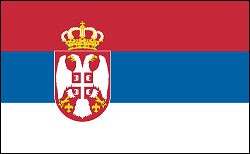Serbia History


The Rule of Slobodan Milosevic Spurs the Breakup of Yugoslavia
After Tito's death on May 4, 1980, a rotating presidency designed to avoid internal dissension was put into effect, and the feared clash of Yugoslavia's multiple nationalities and regions appeared to have been averted. In 1989, Slobodan Milosevic became president of the Serbian republic. His arch-nationalism and calls for Serbian domination inflamed ethnic tensions and spurred on the breakup of Yugoslavia. In May 1991 Croatia declared independence, and by December so had Slovenia and Bosnia. Slovenia was able to break away with only a brief period of fighting, but because 12% of Croatia's population was Serbian, Serb-dominated Yugoslavia fought hard against its secession. Bosnia's declaration of independence led to even more brutal fighting. The most ethnically diverse of the Yugoslav republics, Bosnia was 43% Muslim, 31% Serbian, and 17% Croatian. The largely Serbian-led Yugoslav military pounded Bosnia, and with Yugoslavia's help, the Bosnian Serb minority took the offensive against Bosnian Muslims. It carried out ruthless campaigns of ethnic cleansing, which involved the expulsion or massacre of Muslims. The war did not end until NATO stepped in, bombing Serb positions in Bosnia in Aug. and Sept. 1995. In Nov. 1995, Bosnia, Serbia, and Croatia signed the Dayton Peace Accords, ending the four-year-long war in which 250,000 people died and another 2.7 million became refugees.
Despite entangling his country in almost continuous war for four years and bringing it to near economic collapse, the Serbian government of Slobodan Milosevic maintained its effective control over the remainder of Yugoslavia. Constitutionally barred from another term as president of Serbia, Milosevic became president of the Federal Republic of Yugoslavia (which at this stage consisted of just Serbia and Montenegro) in July 1997.
In Feb. 1998 the Yugoslav army and Serbian police began fighting against the separatist Kosovo Liberation Army, but their scorched-earth tactics were concentrated on ethnic Albanian civilians—Muslims who make up 90% of Kosovo's population. More than 900 Kosovars were killed in the fighting, and the hundreds of thousands forced to flee their homes were without adequate food and shelter. Although Serbs made up only 10% of Kosovo's population, the region figures strongly in Serbian nationalist mythology.
NATO was reluctant to intervene because Kosovo—unlike Bosnia in 1992—was legally a province of Yugoslavia. The proof of civilian massacres finally gave NATO the impetus to intervene for the first time ever in the dealings of a sovereign nation with its own people. NATO's reason for involvement in Kosovo changed from avoiding a wider Balkan war to preventing a human rights calamity. On March 24, 1999, NATO began launching air strikes. Weeks of daily bombings destroyed significant Serbian military targets, yet Milosevic showed no signs of relenting. In fact, Serbian militia stepped up civilian massacres and deportations in Kosovo, and by the end of the conflict, the UN high commissioner for refugees estimated that at least 850,000 people had fled Kosovo. Serbia finally agreed to sign a UN-approved peace agreement with NATO on June 3, ending the 11-week war.







